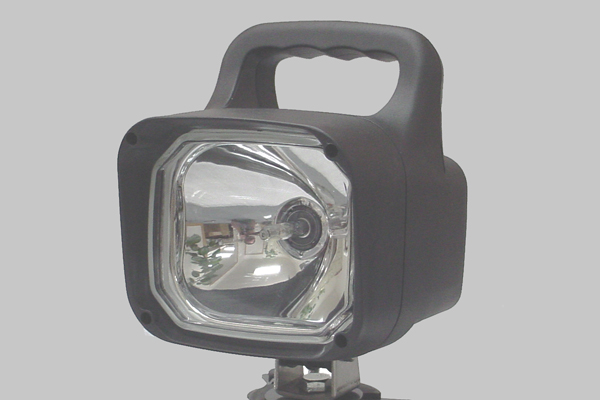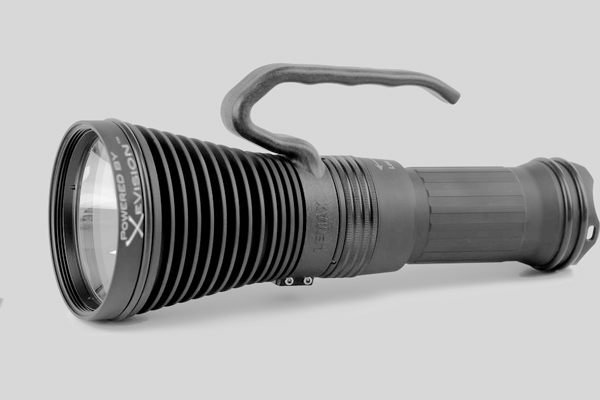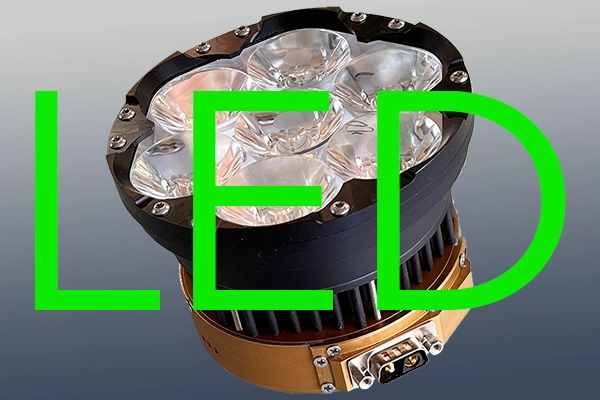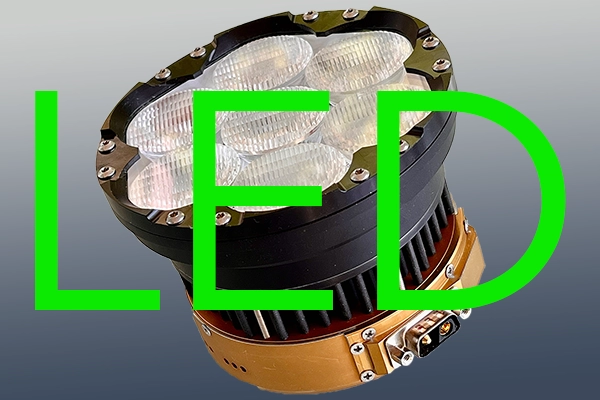Hangar Tech-Talk about HID and LED lighting knowledge
HID lights as aircraft landing lights - soon including LED
Major parts of this article are excerpted from
'Automotive Xenon Metal Halide HID Lamps' by Don Klipstein
for which we are grateful.
- - Introduction
- - XeVision HID Xenon lamps versus conventional landing lights
- - Description of the H.I.D. or HID Xenon lighting system
- - Electrical Requirements
- - Safety and Reliability Requirements
- - Converting & comparing lumens and candelas
- - Photomtry a 101 primer to understand light characteristics
XeVision® H.I.D. (high intensity discharge, or short HID) lamps are actually automotive Xenon Metal Halide type H.I.D. arc discharge lamps which can be successfully applied to aircraft as landing lights.
Light is generated by creating an electrical discharge between two electrodes, within an arc tube made of quartz and filled with a mixture of Xenon and metal halides. The arc tube is sealed again in a glass jacket to filter ultraviolet emissions and as a protection against explosion. A state-of-the-art electronic ballast in a separate unit ignites and sustains the arc which completes the system. The arc produces much more light than a glowing filament, and the light is of a higher "color temperature", meaning that it more closely approximates white daylight.
The H.I.D. lamps are often referred to as xenon lamps but they are more of a specialized metal halide lamp than anything else. The technology in an arc-discharge lamp is exactly the same as an electronic flash of a camera. H.I.D. lamps are essentially versions of the lamps used by photographers, and Stadium lights under which you watch your favorite football team. However, some of these variations take minutes to warm up. The latest H.I.D. lamp systems produce higher than halogen-level light in less than 0.3 seconds of switching them on and reach full intensity very shortly thereafter. The initial warm-up voltage spike runs to tens of thousands of volts. Steady-state system voltage is around 90 VAC These sophisticated operational conditions are controlled by the "smart" electronic ballast.
Our H.I.D. lighting systems consist of the so-called third generation D1S bulb.
The third generation H.I.D. lights have two physical units, the ballast and the light emitting bulb. D1S bulbs have an integrated igniter which was part of the ballast or in between the ballast and the bulb in earlier designs.
The important advantage of the D1S bulbs is that the high voltage (up to 20 kV) is generated in the igniter which is part of the bulb. Therefore no high voltage greater than 1.3 kV is transported from the ballast to the bulb. The electrical connection therefore can be much longer (up to 10 feet) and there is significantly less EMI generated in the electrical wire. As for the D2S systems, their wire harness is short (typically 12" or less) to alleviate the EMI problem to some degree.
The D1S lamps commonly operate at 35 - 50 Watt. They nominally produce at least 3200 lumens (approx. 500,000 candlepower at 35 Watt) of light.
Note: XeVision exclusively uses third-generation HID. systems with D1S Xenon bulbs with integrated igniter. In this setup, there is little EMI and thus reduced RFI due to the fact that the high voltage generating igniter is part of the bulb.
to Top
The picture overlay shows striking illumination differences of our XeVision 35 watt HID Xenon landing light versus the standard 100 Watt incandescent lamp mounted on a Glasair I RG. The XeVision HID light intensity is drastically increased with a much whiter or cooler (closely simulating daylight) color and the light pattern covers an area from a short distance to the airplanes at a distance of 350 ft. with constant intensity. Object identification is much better with HID Xenon lights.
The incandescent lamp, however, has an unfavorable yellowish light cone at a short distance and the light intensity fades out very quickly.
Both photos were taken under the same conditions with a Kodak DC 3400 digital camera with 2.1 Mpixel. The lens was zoomed to 70 mm which makes distant objects appear closer.
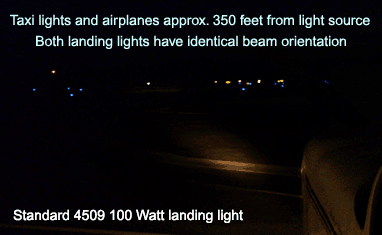
to Top
This sort of lamp consists of a tubular outer bulb approx. 10 mm (.4 inch) in diameter which contains the arc tube (inner bulb). The outer bulb is made of special quartz such as cerium-doped quartz which blocks most ultraviolet, especially the more dangerous short and medium wavelengths as well as much of the 365-366 nM long wave mercury line cluster.
The arc tube or inner bulb is made of plain fused quartz and has tungsten electrodes with the distance between the tips approx. 4.2, maybe 5 millimeters (approx. or slightly under .2 inch). Its construction resembles that of a miniaturized short-arc lamp, but true short-arc lamps have a much more concentrated arc.
The arc tube contains xenon gas at a couple of atmospheres to maybe a few atmospheres when cold and a few to maybe several atmospheres when hot. There is also mercury in the bulb, and when it is vaporized the mercury adds at least 80 atmospheres of pressure for a total pressure of 80 to 100 atmospheres.
Metal halides - salts - are also in the arc tube. The formulation in automotive and aviation HID lamps includes sodium and scandium halides (probably iodides) and maybe traces of others such as lithium and thallium halides.
More ordinary metal halide lamps do not have high pressure xenon but have low pressure argon instead. The high pressure xenon is used to obtain some usable light output during warm-up before the other ingredients have vaporized.
The bright bluish light color of H.I.D. lamps have not been tuned to mimic sunlight. other than tweaking the gas and evaporated-salts mix to conform to regulatory definitions of "white light". The bluish tint is a side effect of using an electrical arc as the light source.
to Top
The electrical requirements of D1 and D2 type lamps are nasty. The D1 and D2 types require a starting pulse. 7 kilovolts may be on an average spark through these bulbs, but for reliability, you need more, 10 or possibly 12 kilovolts. Automotive or aviation use requires the ability to restart a hot bulb with the mercury vapor pressure high, and this requires even more voltage - 12 to 15 kilovolts and maybe even more for good reliability. The usual ballasts supposedly produce starting pulse voltages like 18 kilovolts minimum, 20 kilovolts typical.
D1 type lamps have an integral igniter separate from the ballast. The ballast and igniter work together to start and sustain the arc.
Starting pulses must be repeated frequently until the arc is established.
The ballast must supply an open circuit output voltage - other than the starting pulses - of over 300 volts, preferably 400 or maybe preferably 450 volts - to force the arc to establish.
D1 and D2 type lamps are 35 and 50 watt lamps. Once the arc is established, the ballast must supply limited current or else the arc will draw extreme current and this will be bad for the bulb and/or other parts. The voltage across the lamp is normally around 80-90 volts when it is warmed up, but will be less during warm-up. The ballast must handle a lamp voltage possibly as low as 16 volts early in warm-up, although this voltage usually bottoms out higher - probably at least in the 20's of volts.
The ballast must deliver 35 (50) watts [ballast input power being 42 (61) watts] to the lamp when the voltage across the lamp is between 70 and 110 volts. When this voltage is lower, the ballast must deliver at least .5 amp but generally no more than 2 amps and preferably as close to 35 (50) watts as possible. Higher currents are preferred - a partially warmed-up metal halide lamp sometimes has an unstable arc at lower current.
Ballasts deliver boosted power (above 35 watts) at some times during warm-up to give near-full light output. Note that a xenon arc or a mercury vapor arc does not produce visible light as efficiently as a metal halide arc does. Automotive-grade ballasts with boosted power at some points of warm-up have circuitry that models the thermal characteristics of the bulb. The maximum safe current for the bulb's electrodes must not be exceeded during a power boost during warm-up.
A voltage across the bulb higher than 110 volts only occurs in the early stage of establishing the arc or if the bulb is failing. The ballast should deliver enough power to heat up the electrode tips enough for the arc to establish - more is better and over 35 watts is OK as long as the current is not excessive. But excessive power delivered to an aging bulb can cause the bulb to explode.
D1 and D2 lamps and most other metal halide lamps require AC. DC is tolerable briefly, and then preferably only if the bulb is cold. A DC electric field, hot quartz or hot glass, and salts or alkalis is not a good combination - electrolysis effects can occur which can create weak spots or cracks in the arc tube.
The AC delivered to a D1 or D2 type bulb usually has a frequency of a couple hundred to a few hundred Hz. Higher frequencies are probably OK with D2 types but the igniters in D1 types may only work correctly or even be adequately conductive in a certain range of frequencies.
The AC current waveform in a D1 or D2 type lamp is traditionally a square wave or close to a square wave. Other waveforms have a higher peak current for a given average current or RMS current, and the higher peak current is harder on the electrodes and may shorten the life or cause problems with the use of higher currents during warm-up.
Standard metal halide arc discharge lamps should not be overpowered beyond 50 watts, except where permissible for an accelerated warm-up and near-full light output during warm-up. Overpowering one will shorten its life and increase the risk of the lamp exploding.
Underpowering a metal halide lamp is also bad. If the electrodes are not hot enough, they do not do a good job of conducting electrons into the arc and voltage drop in this process (known as the "cathode fall") is excessive. An excessive cathode fall causes positive ions in the arc to hit the electrode at excessive speed which "sputters" electrode material onto the inner surface of the arc tube.
It is not recommended to operate metal halide lamps at reduced power. Besides the bad effects of high cathode fall on hot electrodes, an unusual temperature pattern can have the chemicals in the arc tube condense in locations that can block some of the light. And if the electrode cathode falls are excessive and unequally so, a DC electric field can result, which can cause destructive electrolysis effects of hot salts on hot quartz. This can cause the arc tube to crack.
Metal halide lamps should have power input within 15 percent of their rated wattage.
to Top
Please note that D1 and D2 type bulbs operate at high temperatures with great pressure probably from 80 to 100 atmospheres. The internal quartz arc tube temperature is probably typically around 800 degrees C (1400-1500 degrees F or so). The outer bulb is not this hot, but it is definitely burning hot. The arc tube always has at least some minuscule risk of exploding and should only be operated in a headlight housing or other suitable container. Improper operation increases the risk of bulb explosion.
The bulb must be clean and free of dirt, grease, organic matter, ash, salt, or alkali. Salts, ash, and alkalis have a tendency to slowly leach into red-hot and nearly red hot quartz which will result in strains, weak spots, and maybe cracks.
A metal halide lamp does not like frequent starting, therefore pulsing landing light systems are not recommended with conventional systems. If used, lamp life expectancy is greatly reduced. Starting causes wear on the electrodes. Excessive evaporation of electrode material will deposit it onto the inner surface of the arc tube which results in darkening and overheating of the arc tube. In D1 and D2 and some other metal halide lamps, there is a halogen cycle that cleans deposited tungsten electrode material from the inner surface of the arc tube. Prolonged continuous operation at proper internal temperatures is required for the halogen cycle to work. However, our new XeVision Pulsing System with our new proprietary XeStrike™ ballast and our patented XePulse™ pulsing modules allow reliable pulsing ('wig-wag') of our XeVision landing and taxi lights.
to Top
A lumen is a unit of light output, equal to 1 / (60 * pi) of the light emitted by one square centimeter of ideal blackbody surface at the melting point of platinum. When the spectrum differs from that of a blackbody at the melting point of platinum, equate lumens by applying the official photopic function to the quantity of light at every wavelength present. One watt of light at any single wavelength (or in a very narrow band) is, in lumens, 681 times the official photopic function of that wavelength. Any eyeballs (or other light sensors) of spectral response deviating from that of the "official standard observer" could see as unequally bright light sources of equal lumens/candela and different spectral output.
A "USA-usual" 100 watt, 120 volt, 750 hour "regular" (A19) light bulb usually produces 1710 lumens.
Lumens per watt is a measure of efficiency in converting electrical energy to light. Multiply this by the watts dissipated in the LED to get lumens. A typical red, orange or yellow , or yellow-green LED has a voltage drop of around 2 volts and is getting around .04 watts at the typical "standard" current of 20 milliamperes. A blue, white, or non-yellowish-green one typically has a voltage drop of 3.5 volts at 20 mA and gets .07 watt at 20 mA.
A candela is a lumen per steradian, or "beam candlepower". The candela is a primarily defined metric unit, equal to 1/60 of the perpendicular/normal "candlepower" of one square centimeter of ideal blackbody surface at the melting point of platinum. So lumens are candelas times the beam coverage in steradians. Candelas are lumens divided by the beam coverage in steradians. Ideally, that is - assuming that all light is within the beam and the "candlepower" is constant within this beam.
So you may now be wondering what a steradian is. It is 1 / (4 * pi) of a whole sphere or 1 / (2 * pi) of a hemisphere or about 3283 "square degrees". To get steradians from the beam angle:
Steradians = 2 * pi * (1 - cos (.5 * (beam angle)))
So if you determine the steradian beam coverage and multiply that by the candela figure, you get the lumen light output - very roughly! The beam is not uniform and it does not contain all of the light. Obtaining lumens from beam angle and candela can easily be in the +100 / - 50 percent range. Actual lumens are generally higher than predicted by this formula with smaller beam angles of 8 degrees or less since the nominal beam does not include a secondary "ring-shaped" "beam" that usually surrounds the main one. Also, note that some beam angle figures are optimistic and could lead one to expect a lot more lumen light output than actually occurs.
to Top
Photometry – Measurement of Light (a compilation)
The complexity of measuring the quantity of light with regards to light source and target has led to confusion and misconceptions. This article is trying to shed light on this topic.
Photometry
Photometry is the science of measurement of light, in terms of its perceived brightness to the human eye. It is distinct from radiometry, which is the science of measurement of light in terms of absolute power; rather, in photometry, the radiant power at each wavelength is weighted by the luminosity function that models human brightness sensitivity.
The human eye is not equally sensitive to all wavelengths of light. Photometry attempts to account for this by weighting the measured power at each wavelength with a factor that represents how sensitive the eye is at that wavelength. The standardized model of the eye's response to light as a function of wavelength is given by the luminosity function. Note that the eye has different responses as a function of wavelength when it is adapted to light conditions (photopic vision), and dark conditions (scotopic vision). Photometry is based on the eye's photopic response, and so photometric measurements will not accurately indicate the perceived brightness of sources in dim lighting conditions. This is important for quantifying the performance of halogen, HID, and LED.
Photometric quantities
Many different units of measure are used for photometric measurements. People sometimes ask why there need to be so many different units, or ask for conversions between units that can't be converted (lumens and candelas, for example). We are familiar with the idea that the adjective "heavy" can refer to weight or density, which are fundamentally different things. Similarly, the adjective "bright" can refer to a lamp, which delivers a high luminous flux (measured in lumens), or to a lamp, which concentrates the luminous flux it has into a very narrow beam (candelas). Because of the ways in which light can propagate through three-dimensional space, spread out, become concentrated, reflect off shiny or matte surfaces, and because light consists of many different wavelengths, the number of fundamentally different kinds of light measurements that can be made is large, and so are the numbers of quantities and units that represent them.
SI photometry units
SI photometry units
radiant energy per unit time, also called radiant power. Sometimes confusingly called "intensity".
power incident on a surface. Sometimes confusingly called "intensity".
There are two parallel systems of quantities known as photometric and radiometric quantities (see table above). Every quantity in one system has an analogous quantity in the other system. For example:
* Luminance (photometric) and radiance (radiometric)
* Luminous flux (photometric) and radiant flux (radiometric)
* Luminous intensity (photometric) and radiant intensity (radiometric)
In photometric quantities, every wavelength is weighted according to how visible it is, while radiometric quantities use un-weighted absolute power. For example, the eye responds much more strongly to green light than to red, so a green source will have higher luminous flux than a red source with the same radiant flux would. The light outside the visible spectrum does not contribute to photometric quantities at all, so for example a 1000 watt space heater may put out a great deal of radiant flux (1000 watts, in fact), but as a light source it puts out very few lumens (because most of the energy is in the infrared, leaving only a dim red glow in the visible).
Radiant flux (watts) versus luminous flux (lumens)
In radiometry, radiant flux or radiant power is the measure of the total power of electromagnetic radiation (including visible light). The power may be the total emitted from a source, or the total landing on a particular surface.
In photometry, luminous flux or luminous power is the measure of the perceived power of light. It differs from radiant flux, the measure of the total power of light emitted, in that luminous flux is adjusted to reflect the varying sensitivity of the human eye to different wavelengths of light.
The SI unit of luminous flux is the lumen (lm). One lumen is defined as the luminous flux of light produced by a light source that emits one candela of luminous intensity over a solid angle of one steradian. In other systems of units, luminous flux may have units of power.
The luminous flux accounts for the sensitivity of the eye by weighting the power at each wavelength with the luminosity function, which represents the eye's response to different wavelengths. The luminous flux is a weighted sum of the power at all wavelengths in the visible band. The light outside the visible band does not contribute. The ratio of the total luminous flux to the radiant flux is called the luminous efficacy.
Luminous flux is often used as an objective measure of the useful power emitted by a light source and is typically reported on the packaging for light bulbs, although it is not always prominent. Energy-conscious consumers commonly compare the luminous flux of different light bulbs, since it provides an estimate of the apparent amount of light the bulb will produce and is useful even when comparing different technologies, such as incandescent and compact fluorescent bulbs. For example, a typical 100 watt 120 Volt incandescent light bulb emits about 1700 lumens. Roughly the same amount of light can be produced at a quarter the power (although at greater initial cost) by a 25 watt compact fluorescent light bulb. The article on luminous efficacy has more information on the efficiency of different light sources.
It is wrong or at least imprecise to refer to luminous flux as a measure of "brightness" since, for example, a nearby source of light may appear much brighter than a faraway source with much higher luminous flux. This is because not all of the emitted flux is received by your eye, and you receive less flux from sources that are farther away. In general, brightness has no unambiguous scientific meaning and should be used only for non-quantitative references to physiological sensations and perceptions of light.
Luminous flux should not be confused with another photometric unit, luminous intensity is a measure of the wavelength-weighted power emitted by a light source in a particular direction, based on the luminosity function, a standardized model of the sensitivity of the human eye. The SI unit of luminous intensity is the candela (cd), an SI base unit.
A comparison of the watt and the lumen illustrates the distinction between radiometric and photometric units.
The watt is a unit of power. We are accustomed to thinking of light bulbs in terms of power in watts. But power is not a measure of the amount of light output. It tells you how quickly the bulb will increase your electric bill, not how effective it will be in lighting your home. Because incandescent bulbs sold for "general service" all have fairly similar characteristics, power is a guide to light output, but only a rough one.
Watts can also be a measure of output. In a radiometric sense, an incandescent light bulb is about 80% efficient; 20% of the energy is lost (e.g. by conduction through the lamp base). The remainder is emitted as radiation. Thus, a 60 W light bulb emits a total radiant flux of about 45 watts.
Incandescent bulbs are, in fact, sometimes used as heat sources, but usually, they are used for the purpose of providing light. As such, they are very inefficient, because most of the radiant energy they emit is invisible infrared.
The lumen is the photometric unit of light output. Although most consumers still think of light in terms of power consumed by the bulb, in the U.S. it has been a trade requirement for several decades that light bulb packaging gives the output in lumens. The package of a 60-watt incandescent bulb indicates that it provides about 900 lumens, as does the package of the 15-watt compact fluorescent. A "USA-usual" 100 watt, 120 volt, 750 hour "regular" (A19) light bulb usually produces 1710 lumens.
The lumen is defined as the amount of light given into one steradian by a point source of one candela strength; while the candela, a base SI unit, is defined as the luminous intensity of a source of monochromatic radiation, of frequency 540 terahertz, and a radiant intensity of 1/683 watts per steradian. (540 THz corresponds to about 555 nm, the wavelength defining green, to which the human eye is most sensitive. The number 1/683 was chosen to make the candela about equal to the standard candle, the unit which it superseded).
Combining these definitions, we see that 1/683 watt of 555 nm green light provides one lumen, or 1 watt (555 nm) will generate max. 683 Lumens.
The definition tells us that 1 watt of pure green 555 nm light is "worth" 683 lumens. It does not say anything about other wavelengths. Because lumens are photometric units, their relationship to watts depends on the wavelength according to how visible the wavelength is. Infrared and ultraviolet radiation, for example, are invisible and do not count. One watt of infrared radiation (which is where most of the radiation from an incandescent bulb falls) is worth zero lumens. Within the visible spectrum, wavelengths of light are weighted according to a function called the "photopic spectral luminous efficiency." According to this function, 700 nm red light is only about 4% as efficient as 555 nm green light. Thus, one watt of 700 nm red light is "worth" only 27 lumens.
HID bulbs are designed to last up to 30 times longer than standard incandescent landing lights, typically around 3,000 hours. But should you ever need a replacement, you can purchase a D1S HID capsule from us (see products). Both 14 VDC and 28 VDC HID lamps use the same D1S bulb
Efficacy and efficiency
In some other systems of units, luminous flux has the same units as radiant flux. The luminous efficacy is then dimensionless. In this case, it is often instead called the luminous efficiency or luminous coefficient and may be expressed as a percent. For example, it is common to express the luminous efficiency in units where the maximum possible efficacy, 683 lm/W, corresponds to an efficiency of 100%. The distinction between efficacy and efficiency is not always carefully maintained in published sources, so it is not uncommon to see "efficiencies" expressed in lumens per watt, or "efficacies" expressed as a percentage.
Our 50 Watt D1S based XeVision HID Xenon metal halide arc discharge lights reach luminous efficacies up to 109 lumens/watt ‘overall’.
Source and target or RADIANCE and ILLUMINANCE
1. "Brightness" or radiance of a source
Brightness is an attribute of visual perception in which a source appears to emit a given amount of light. In other words, brightness is the perception elicited by the luminance of a visual target. This is a subjective attribute/property of an object being observed.
Radiance is another way of saying how much energy is released from that light source. Again, you measure it at the source. Unless you're talking about measuring the radiance of something intensely hot, like the Sun. Then you might want to measure it at night when it's off.
Brightness was formerly used as a synonym for the photometric term luminance and (incorrectly) for the radiometric term radiance. According to Federal Standard 1037C, "brightness" should now be used only for non-quantitative references to physiological sensations and perceptions of light.
In the RGB color space, brightness can be thought of as the arithmetic mean μ of the Red, Green, and Blue color coordinates (although some of the three components make the light seem brighter than others, which, again, can be compensated by some display systems automatically):
\mu = {R + G + B / 3 }.
2. llluminance on illuminated target
How much light is falling on something a certain distance away from the light source.
Illuminance is what results from the use of light. You turn your flashlight on in a dark room, and you light something up. That's ILLUMINANCE. Turning on a light in a dark room to make the burglar visible gives you ILLUMINANCE. It also gives you another problem when you note the burglar is pointing your duck gun at your belly button. Illuminance is the intensity or degree to which something is illuminated and is therefore not the amount of light produced by the light source. This is measured in foot-candle again!
illuminance is the total luminous flux incident on a surface, per unit area. It is a measure of the intensity of the incident light, wavelength-weighted by the luminosity function to correlate with human brightness perception. Similarly, luminous emittance is the luminous flux per unit area emitted from a surface. Luminous emittance is also known as luminous exitance.
In SI-derived units, these are both measured in lux (lx) or lumens per square meter (cd·sr·m-2). In the CGS system, the unit of illuminance is the phot. One phot is equal to 10,000 lux.
Illuminance was formerly often called brightness, but this leads to confusion with other uses of the word. "Brightness" should never be used for quantitative description, but only for non-quantitative references to physiological sensations and perceptions of light.
Definitions
LUMENS
A lumen is a way of measuring how much light gets to what you want to light! A Lumen is equal to one foot-candle falling on one square foot of area.
LUX
And when people talk about LUX, it's illuminance measured in metric units rather than English units of measure. To reinforce that, LUX is the measurement of actual light available at a given distance. One lux equals one lumen incident per square meter (instead o square foot) of illuminated surface area
Candlepower
Candlepower is a way of measuring how much light is produced by a light bulb, LED or by striking an arc in a Carbon-Arc spotlight. Is it a measure of how much light falls upon an object some distance away? No. That's illuminance. Is it a measure of how well we see an object that is illuminated by that light source? No. That's something all together different, and we are not going there.
Nowadays we use the term CANDELA instead of candlepower.
Candela Unit of luminous intensity (cd)
Originally, each country had its own, and rather poorly reproducible, unit of luminous intensity; it was necessary to wait until 1909 to see a beginning of unification on the international level when the national laboratories of the United States of America, France, and Great Britain decided to adopt the international candle represented by carbon filament lamps. Germany, at the same time, stayed with the Hefner candle, defined by a flame standard, and equal to about nine-tenths of an international candle. But a standard based on incandescent lamps, and consequently dependent upon their stability, would never have been fully satisfactory and could therefore be only provisional; on the other hand, the properties of a blackbody provided a theoretically perfect solution and, as early as 1933, the principle was adopted that new photometric units would be based on the luminous emission of a blackbody at the freezing temperature of platinum (2045 K).
The units of luminous intensity based on flame or incandescent filament standards in use in various countries before 1948 were replaced initially by the "new candle" based on the luminance of a Planckian radiator (a blackbody) at the temperature of freezing platinum. This modification had been prepared by the International Commission on Illumination (CIE) and by the CIPM before 1937 and was promulgated by the CIPM in 1946. It was then ratified in 1948 by the 9th CGPM which adopted a new international name for this unit, the candela (symbol cd); in 1967 the 13th CGPM gave an amended version of the 1946 definition.
In 1979, because of the experimental difficulties in realizing a Planck radiator at high temperatures and the new possibilities offered by radiometry, i.e., the measurement of optical radiation power, the 16th CGPM (1979) adopted a new definition of the candela:
The candela is the luminous intensity, in a given direction, of a source that emits monochromatic radiation of frequency 540 x 1012 hertz and that has a radiant intensity in that direction of 1/683 watt per steradian. (National Institute of Standards Reference on Constants, Units, and Uncertainty)
Candlepower, or CANDELA is a measure of how much light the bulb produces, measured at the bulb, rather than how much falls upon the thing you want to light up. Further confusing the matter is beam focus. That's how much candlepower can be focused by using a reflector/lens assembly. Obviously, if you project all your light bulbs intensity at a given spot, or towards something, it will be more intense, and the illuminance will be higher.
A candlepower as a unit of measure is not the same as a foot-candle. A candlepower is a measurement of the light at the source, not at the object you light up. And a candela is the metric equivalent of the light output of that one candle, based on metric calculations.
Foot-candle
A foot-candle (sometimes footcandle; abbreviated fc, lm/ft, or ft-c) is a non-SI unit of illuminance or light intensity widely used in photography, film, television, and the lighting industry.
The unit is defined as the amount of illumination the inside surface an imaginary 1-foot radius sphere would be receiving if there were a uniform point source of one candela in the exact center of the sphere. Alternatively, it can be defined as the illuminance on a 1-square foot surface of which there is a uniformly distributed flux of one lumen. This can be thought of as the amount of light that actually falls on a given surface. The foot-candle is equal to one lumen per square foot.
The SI-derived unit of illuminance is the lux. One foot-candle is equal to 10.76 lux, although in the lighting industry, typically this is approximated as 1 foot-candle being equal to 10 lux.
Full, unobstructed sunlight has an intensity of approximately 10,000 fc. An overcast day will produce an intensity of around 1,000 fc. The intensity of light near a window can range from 100 to 5,000 fc, depending on the orientation of the window, time of year and latitude.
Foot-candles can be easily measured and calculated with the use of a (manual) camera equipped with a built-in light meter. With the film speed set to ASA 25 and the shutter speed set to 1/60th of a second, focus on a sheet of white paper placed in the area where intensity is to be measured. Adjust the f-stop for proper exposure. Each f-stop has an approximate corresponding foot-candle reading (see the table below).
Footcandle versus Lux
One footcandle ≈ 10.764 lux. The footcandle (or lumen per square foot) is a non-SI unit of illuminance. Like the BTU, it is obsolete but it is still in fairly common use in the United States, particularly in construction-related engineering and in building codes. Because lux and footcandles are different units of the same quantity, it is perfectly valid to convert footcandles to lux and vice versa.
The name "footcandle" conveys "the illuminance cast on a surface by a one-candela source one foot away." As natural as this sounds, this style of name is now frowned upon, because the dimensional formula for the unit is not foot · candela, but lumen/sq ft. Some sources do however note that the "lux" can be thought of as a "meter-candle" (i.e. the illuminance cast on a surface by a one-candela source one meter away). A source that is farther away casts less illumination than one that is close, so one lux is less illuminance than one footcandle. Since illuminance follows the inverse-square law, and since one foot = 0.3048 m, one lux = 0.30482 footcandle ≈ 1/10.764 footcandle.
In practical applications, when measuring room illumination, it is very difficult to measure illuminance more accurately than ±10%, and for many purposes, it is quite sufficient to think of one footcandle as about ten lux.
Steradian
The steradian (symbol: sr) is the SI unit of solid angle. It is used to describe two-dimensional angular spans in three-dimensional space, analogous to the way in which the radian describes angles in a plane. The name is derived from the Greek stereos for "solid" and the Latin radius for "ray, beam".
The steradian is dimensionless because 1 sr = m2·m-2 = 1. It is useful, however, to distinguish between dimensionless quantities of different nature, so in practice, the symbol "sr" is used where appropriate, rather than the derived unit "1" or no unit at all. As an example, radiant intensity can be measured in watts per steradian (W·sr-1).
So you may now be wondering what a steradian is. It is 1 / (4 * pi) of a whole sphere or 1 / (2 * pi) of a hemisphere or about 3283 "square degrees". To get steradians from the beam angle:
Steradians = 2 * pi * (1 - cos (.5 * (beam angle)))
Wrapping things up
Defining light emitting from the source:
Luminous intensity is a measure of the wavelength-weighted power emitted by a light source in a particular direction, based on the luminosity function, a standardized model of the sensitivity of the human eye. The SI unit of luminous intensity is the candela (cd), an SI unit.
Luminous flux is the total perceived power emitted in all directions.
Luminance (Candela/m2)
Candela Unit of luminous intensity (cd). Nowadays we use the term candela instead of candlepower.
Candlepower is a rating of light output at the source, using English measurements.
Defining light illuminating a target:
Foot-candles tell us how much of that light is directed at an object we want to illuminate. Foot-candles are a measurement of light at an illuminated object.
Lumen is a metric equivalent to foot-candles in that it ismeasured at an object you want to illuminate.
Luminous flux or luminous power = lumen (cd·sr)
LUX is an abbreviation for Lumens per square meter. Foot-candles equal the number of Lumens per square feet of area. One candlepower equals 12.57 lumens. Remember foot-candles represent illuminance. And we are measuring luminance.
Luminance (LUX)
Luminous efficacy (Lumens/W) overall (target light power/ source input power) describes the efficiency of a light source.
Lumens to candlepower conversion:
A light source (candle) radiates light equally in all directions). Visualize a transparent sphere one meter in radius surrounds your candle. There are 12.57 square meters of surface area in such a sphere.
The amount of energy emanating from one square meter of surface is one lumen. If we decrease the size of the sphere to one foot radius, we increase the reflected energy 12.57 times that which fell on the square meter area.
Divide the number of lumens by 12.57 and you get the candlepower equivalent of that light source.
We've now converted a measurement taken some distance from the illuminated object, converted it from a metric standard to an English unit of measure, and further converted it from a measure of illumination to a measure of radiation.







